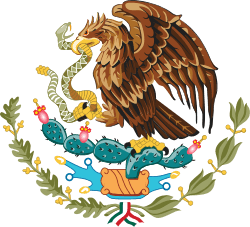La Reforma
Part of a series on the |
|---|
| History of Mexico |
 |
|
Spanish rule |
|
1864–1928 |
| Timeline |
| Mexico portal |
La Reforma (English: The Reform) was a period halfway through the 19th century in the history of Mexico that was characterized by liberal reforms designed to modernize Mexico and make it into a nation state. The major goals in this movement were: Land reform—redistribution of land, separation of church and state, and increased educational opportunities for the poor, the majority of the country's population. The liberals' strategy was to sharply limit the traditional privileges land holdings of the Catholic Church and thereby revitalize the market in land. The Church fought back and the gains were limited. No class of small peasants identified with the Liberal program emerged, but many merchants acquired land (and tenant farmers). Many existing landowners expanded their holdings at peasant expense, and some upwardly mobile ranch owners, often mestizos, acquired land.[1]
History
Notable liberal politicians in the reform period include Benito Juárez, Juan Álvarez, Ignacio Comonfort, Miguel Lerdo de Tejada, Sebastián Lerdo de Tejada, Melchor Ocampo, José María Iglesias and Santos Degollado.
The Reforma is usually considered to have begun with the overthrowing and removal of Antonio López de Santa Anna in the Revolution of Ayutla in 1855. There is less consensus about the ending point of the Reforma. Common dates are 1861, after the liberal victory in the Reform War, 1867, after the republican victory of the French intervention in Mexico and 1876 after the Rebellion of Tuxtepec in which Porfirio Díaz overthrew president Sebastián Lerdo de Tejada.
Reforms
The most noteworthy reforms of the Reforma were:
- the Ley Lerdo, abolishing clerical and communal properties.
- the Ley Juárez, abolishing separate military and religious courts
- the Mexican Constitution of 1857, guaranteeing many civil and political liberties including freedom of religion
- the 'Reform Laws' in which the liberal government of Veracruz during the civil war against the conservatives proclaimed complete separation of church and state.
Paseo de la Reforma
Mexico City's main avenue is the Paseo de la Reforma which received its current name after the Reforma.
It was originally known as the Paseo de la Emperatriz after Empress Carlota, the consort of Emperor Maximilian I of Mexico who created the avenue for her.
Notes
- ↑ Gilbert Michael Joseph; Timothy J. Henderson (2002). The Mexico Reader: History, Culture, Politics. Duke University Press. p. 239ff.
Further reading
- Bazant, Jan. Alienation of Church Wealth in Mexico: Social and Economic Aspects of the Liberal Revolution 1856-75 (Cambridge University Press, 1971)
- Callcott, Wilfred H. Liberalism in Mexico 1857-1929 (Stanford University Press, 1931)
- Hamnett, Brian R. Juarez (1994)
- Hamnett, Brian R. "Reform Laws" in Michael S. Werner, ed. Encyclopedia of Mexico: History, Society & Culture (1997) Volume: 2 pp 1239–41.
- Knowlton, Robert J. Church Property and the Mexican Reform 1856-1910 (Northern Illinois University Press, 1976)
- Powell, T.G. "Priests and Peasants in Central Mexico: Social Conflict during 'La Reforma,'" Hispanic American Historical Review (1977) 57#2 pp. 296–313 in JSTOR
- Scholes, Walter V. Mexican Politics during the Juárez Regime 1855-1872 (University of Missouri Press, 1957)
- Sinkin, Richard N. The Mexican Reform, 1856-1876:A Study in Liberal Nation-Building (University of Texas Press, 1979)
See also
- Reform War (1857–1861)
- French intervention in Mexico (1861–1867)